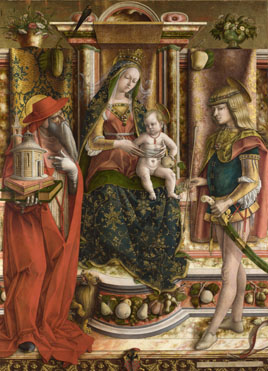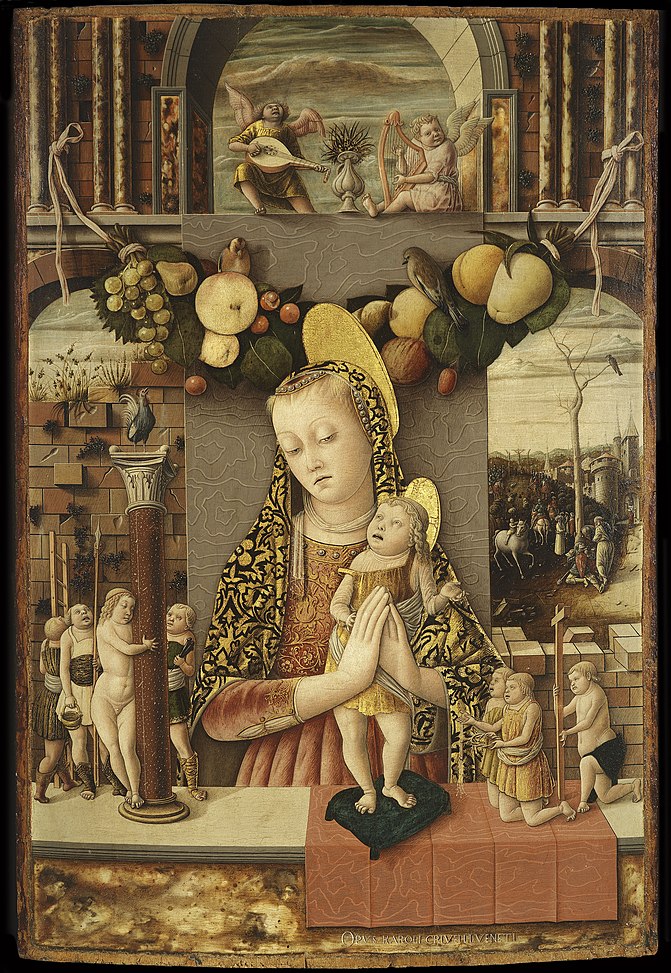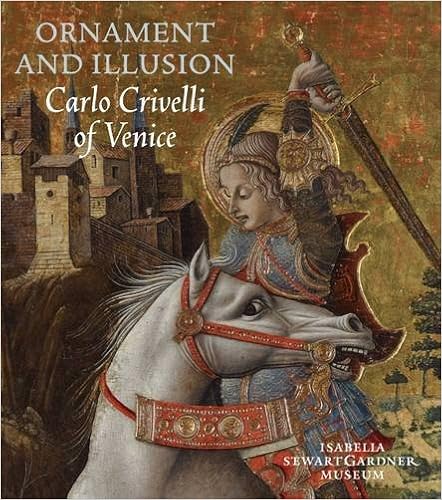Carlo Crivelli, Saint George Slaying the Dragon, 1470, tempera, gold, and silver on panel, 94 x 47.8 cm, Isabella Stewart Gardner Museum, Boston
The Isabella Stewart Gardner Museum in Boston will be the
sole venue for the first ever monographic exhibition dedicated to Carlo
Crivelli in the United States. Ornament and Illusion: Carlo Crivelli of
Venice opens Oct. 22 and runs through Jan. 25, 2016.
Carlo Crivelli (about1435–about1495) is one of the most important–and historically neglected –artists of the Italian Renaissance. Distinguished by radically expressive compositions, luxuriant ornamental display, and bravura illusionism, his works push the boundaries between painting and sculpture.
Carlo Crivelli (about1435–about1495) is one of the most important–and historically neglected –artists of the Italian Renaissance. Distinguished by radically expressive compositions, luxuriant ornamental display, and bravura illusionism, his works push the boundaries between painting and sculpture.
Crivelli
manipulated the surface of each one with rare mastery of his medium, crafting
visionary encounters with the divine, forging the modern icon, and offering a
powerful alternative to new models of painting associated with Florence.
The
exhibition brings together 23 paintings and the artist’s only known drawing.
Newly cleaned and restored, the Gardner’s iconic Saint George Slaying the
Dragon is the focal point for a two-part installation. The first reunites four
of six surviving panels from
Crivelli’s Porto San Giorgio altarpiece,
of which the Gardner painting is a fragment. The second part introduces visitors to the artist’s repertoire of dazzling pictorial effects with some of his most important works in Europe and the United States.
Crivelli’s Porto San Giorgio altarpiece,
of which the Gardner painting is a fragment. The second part introduces visitors to the artist’s repertoire of dazzling pictorial effects with some of his most important works in Europe and the United States.
Included
in Ornament and Illusion are unprecedented loans from
La Madonna della Rondine (The Madonna of the Swallow) from Altarpiece from S. Francesco dei Zoccolanti, Matelica
La Madonna della Rondine (The Madonna of the Swallow) from Altarpiece from S. Francesco dei Zoccolanti, Matelica
Predella of La Madonna della Rondine
The above paintings were part of a single altarpiece. Complete in its original frame, it is one of only three large Italian Renaissance pictures in the National Gallery to retain their original frames. The gilded frame is striking for its 'all'antica' form and rich variety of colour simulating porphyry, granite and marble. It was commissioned in March 1490 by Ranuzio Ottoni, Lord of Matelica, and Giorgio di Giacomo, guardian of the local Franciscan convent. The altarpiece represents the Virgin and Child enthroned with Saint Jerome and Saint Sebastian, but it is named after the swallow ('rondine' in Italian) perched above, which may be intended as a symbol of the Resurrection. It comes from San Francesco in Matelica and bears the arms of the Ottoni family. It was commissioned in March 1490 by Ranuzio Ottoni, Lord of Matelica, and Giorgio di Giacomo, guardian of the local Franciscan convent. Crivelli signed himself 'Miles' (Latin: knight), a title he received in 1490. The central scenes of the predella, the lower section of the altarpiece, relate to the main figures above. They are, from left to right, Saint Jerome in the Wilderness, the Nativity at Night, and the Martyrdom of Saint Sebastian. At either end are Saint Catherine of Alexandria, with her traditional attribute of a wheel, and Saint George in combat with the dragon.
The National Gallery, London;
The Virgin Annunciate
the Städelsches Kunstinstitut und Städtische Galerie, Frankfurt;
Madonna della Passione
the Museo di Castelvecchio, Verona;
Madonna and Child Enthroned with Donor
"Remember me, O Mother of God. O Queen of Heaven, rejoice." These words, taken from an Easter psalm sung in the Virgin's honor, appear on the golden arch at the top of Carlo Crivelli's Madonna and Child Enthroned with Donor. The donor, the Albanian ecclesiastic Prenta di Giorgio, kneels in prayer near the Virgin's crown. Crivelli's painting originally constituted the central section of a polyptych in the parish church at Porto San Giorgio, near Fermi. The crisp, sculptural forms reflect Crivelli's probable training in the humanist center of Padua. Yet the manner in which Crivelli's figures are modeled in light and shade also expresses a broader Renaissance concern with direct observation of nature.
the National Gallery of Art, Washington, D.C.; and
This emotionally charged image of the Pietà probably comes from the uppermost tier of an altarpiece Crivelli painted for the church of San Domenico at Ascoli Piceno in the Marches. Known as the Demidoff altarpiece, it is widely considered Crivelli's masterpiece; the principal panels are in the National Gallery, London. Crivelli's art contrasts ornamental effects with details of extreme realism—such as the wounded hand hanging over the tomb’s edge. The fine seventeenth-century frame was made for it by the Barberini family in Rome whose emblem—the bee—adorns each corner.
the Metropolitan Museum of Art, New York City.
Together, the works assembled in Boston reveal the artist’s astonishing skill, encompassing artistic vision, and relentlessambition, restoring Crivelli to his rightful place in the pantheon of Renaissance painters.
Crivelli
was esteemed in his own time as a painter of rank and status. Born in Venice,
he trained locally and joined a workshop in the mainland city of Padua,
learning from the same master as the celebrated artist Andrea Mantegna (1430/1–1506).
Exiled for adultery shortly after returning to Venice in 1457, Crivelli then embarked
on a peripatetic career. Early successes on both sides of the Adriatic led to prestigious
commissions in the Marches, a mountainous region of northeast Italy defined by
its religious and ethnic diversity and ruled by competing feudal lords. He
signed the immense high altarpieces for the cathedrals of Ascoli Piceno, in
1473, and Camerino, around 1490. Recognized for his remarkable artistic accomplishments
with the aristocratic title of “knight,” Crivelli died around 1494.
The
exhibition is organized b y guest co-curator Stephen J. Campbell (Henry and
Elizabeth Wiesenfeld Professor, Johns Hopkins University), guest co-curator Oliver
Tostmann (Susan Morse Hills Curator of European Art, Wadsworth Athenaeum), and
Nathaniel Silver (Assistant Curator of the Collection,Isabella Stewart Gardner
Museum).
Ornament
and Illusion: Carlo Crivelli of Venice is accompanied by a catalog edited by
Stephen J. Campbell. Seven essays challenge the prevailing view of Crivelli as
a provincial artist working in an anachronistic “gothic” style, investigate the
facture of his paintings, and shed new light on his rediscovery by collectors.
Catalog entries deliver new insights and up-to-date bibliography for each work
in the exhibition. Contributing authors include C. Jean Campbell (Emory University),
Francesco De Carolis (Università di Bologna),Thomas Golsenne (École Nationale
Supérieure d’Art de Nice), Gianfranco Pocobene (Isabella Stewart Gardner
Museum), and Alison Wright (University College London).
Great review
Great review






